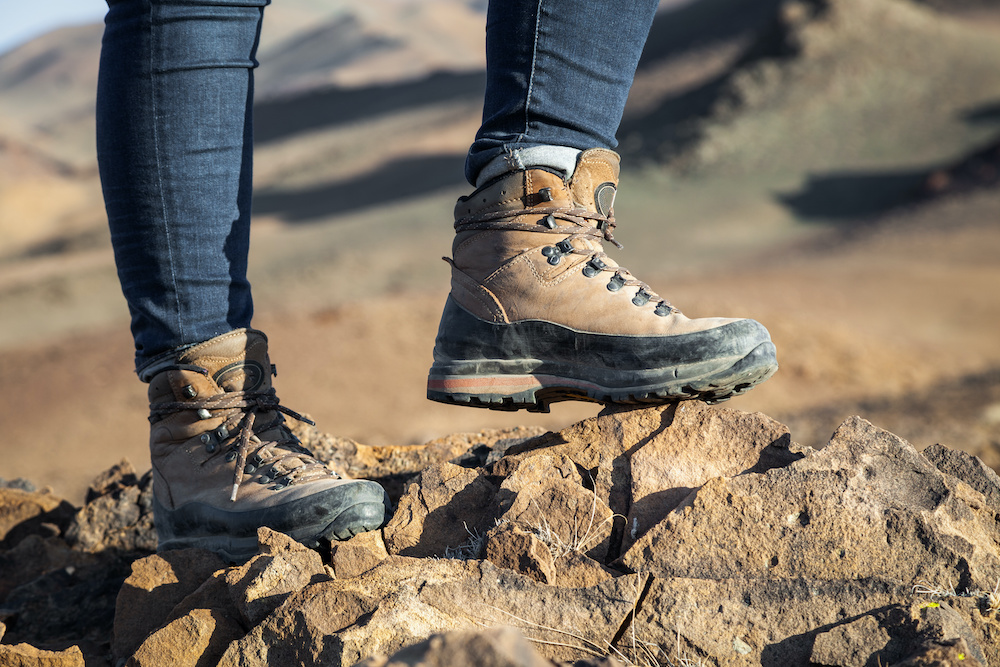
Over the years, a lot of new designs for backpacking gear and apparel are being developed by different sports brands.
As such, you may have been confused and overwhelmed when it came to choosing which shoes are better.
You must weigh your options between approach shoes vs hiking shoes as you take into consideration the comfort it provides and its practicality.
Which of this two outdoor footwear do you need for your activities?
Approach Shoes vs Hiking Shoes
Wearing the wrong footwear for any outdoor activity can lead to premature leg tiredness and other foot discomforts.
Let’s take a closer look at approach shoes and hiking shoes to help you decide which match your needs and preferences.
What Are Approach Shoes?
Approach shoes are popular among climbers.
In fact, they consider this type of footwear as one of the basic needs of the climbing community.
In recent years, these shoes, with its grippy soles, have been making its name known in the backpacking world, as well.
Approach shoes have combined features of hiking and climbing shoes.
They are created for the hike and scramble, which is the approach up to the beginning of rock-climbing areas.
These shoes were created with climbers in mind; they can use it as they face a semi-technical approach before the actual climb.
Approach shoes have the same sticky rubber soles as climbing shoes, which can grip even slippery rocks.
The upper part of the approach shoes has the same construction as climbing shoes, including its durability and the way it protects and supports the foot.
These shoes have the same fit as hiking shoes, with its roomy toe box that allows you to comfortably spread your feet on the innersole.
They are great when it comes to trail hiking because of their lightness, comfort, and breathability.
What Are Hiking Shoes?
These are the go-to shoes of casual hikers because of their comfort and flexibility, which are somewhat similar to sneakers.
Sturdy and stable hiking shoes are created to protect your feet so that you are protected from bruises and abrasions you can get from the rough terrain.
Hiking shoes are lighter compared to hiking boots, making it perfect in strengthening your feet and ankle so that you are less prone to injuries.
You can rely on hiking shoes to provide you with the right support and comfort that will last a long time.
Hiking shoes do not have sticky rubber soles that are vital in climbing shoes.
Instead, they feature hard rubber materials that are more durable and can last longer than the sticky ones.
However, the durable rubber soles of hiking shoes do not offer excellent friction on smooth rocks and wet terrains.
Best Uses for Your Shoes
The different trails and distances that you come across as you approach or go down from places you have climbed require different responses from your footwear.
Where should you use your approach shoes and hiking shoes?
Approach Shoes
Approach shoes have unique features that will let you cross a rocky landscape better than your hiking shoes.
It’s flat and soft outsole allows you to trek uneven terrain with additional traction, boosting your confidence in the process.
Approach shoes are also best used for semi-technical approaches, scrambling, and climbing.
You can also use it for casual walks, trail hiking on wet terrain, and mountain biking with flat pedals.
Hiking Shoes
Hiking shoes are exceptional when trekking on well-maintained, even trails because they do not pose any danger to the hiker.
These are also the perfect shoes to wear if you plan to go on day hikes.
That’s because they are lightweight, flexible, and durable, lowering foot strain.
Trail running is another activity that will be perfect for your hiking shoes since most of these activities are done in warm climates and easy-to-follow tracks.
It is also best to use your hiking shoes while walking around the campsite.
How to Care for Your Shoes
All of us want our footwear to reach their maximum longevity; hence, we will offer tips on how you can take care of them and make them last a long time.
Approach Shoes
Approach shoes are quite expensive, so you need to keep them clean to ensure that you can use them for a long time.
We all know that they go through a lot of different situations and environments every time you go out.
So, every time you come home after an adventure, spray your shoes with water if they are too dirty and leave them out to air dry completely.
You can also use warm water and a soft-bristled brush to remove the dried mud and dirt.
Then, turn the shoes sideways after stuffing them with old newspaper to absorb the moisture and speed up drying.
While you are outside, you can occasionally remove the insole and shake your shoes to remove all the collected dirt inside the approach shoes.
If the upper part of your approach shoes is made from leather, apply some waterproofing or a leather conditioning product to it.
Taking care of the leather material with those products will help in repelling water, preventing any damage to your shoes.
Climbers would often put on some seam grips along the seams of the shoes as a way of strengthening the shoes and protecting them from any wearing down from cracks.
Applying treatment is an excellent practice in taking care of your approach shoes, primarily if the shoes will be used for technical climbing.
Hiking Shoes
Caring for your hiking shoes is vital to its life span and excellent condition maintenance, whatever material they are made of.
Make sure to clean the shoes every time it gets dirty, especially when it’s covered with soil.
Shake off the soles of your shoes against each other to remove dust and mud and then clean the uppers by scrubbing it with a soft-bristled brush soaked in warm water.
To maintain the excellent level of performance of your hiking shoes, ensure that it is always dry from sweat or water.
You can always remove the insole every time you take off the shoes to allow them to breathe and dry up any moisture.
Do not subject the shoes to direct heat to speed up drying so as not to deform them; instead, let it dry naturally at room temperature.
Stuffing the cavities of the shoes with old newspapers helps in absorbing moisture and maintaining the shape of the hiking shoes.
If you need to apply any treatment to the shoes, make sure that it has completely dried before you put on any treatment products for effectiveness.
You can use a waterproofing spray on your shoes to restore its water repellency and prevent any moisture from entering the hiking shoes.
You can do this treatment at least twice a year to maintain its water-repellent feature.
Remember to open the windows as you spray the shoes to avoid inhaling the chemicals.
Then, let it dry for at least 12 hours so that the shoes can fully absorb the treatment.
Dry your shoes thoroughly before you store them away in a well-ventilated and dry place away from any heat source.
Do not store your shoes inside the boot of the car or in direct sunlight, as it will damage the shoes.
If you are not using the shoes for a long time, load it with newspapers to maintain its original shape.
Conclusion
We all have our individual preferences when it comes to footwear; hence, what’s best for one person may not work for you.
It does not matter if the shoes you are accustomed to wearing is not constructed for that purpose.
As long as you are comfortable with your choice, then there’s no problem.
Comparing the features between approach shoes vs hiking shoes showed that comfort and reliability are essential for the user.
